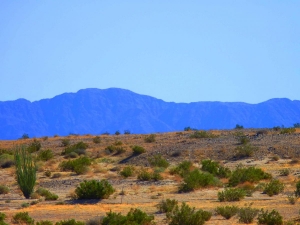
December 28, 2010 (Blythe, CA)-- La Cuna de Aztlan Sacred Sites Protection Circle, a Native American cultural protection group, filed a lawsuit yesterday in the U.S. District Court, Southern District of California, challenging the Bureau of Land Management permitting processes regarding six large solar facilities planned for the Mohave, Sonoran and Colorado deserts of Southern California (Case No.10CV2664 WQH WVG), including an Imperial Valley Solar project slated to hook up to SDG&E’s Sunrise Powerlink.
Patricia Pinon, Chairperson of La Cuna's Advisory Committee, said the group was joined by Californians for Renewable Energy (CARE), and six individual Native American plaintiffs. Pinon indicates La Cuna de Aztlan Sacred Site Protection Circle has standing to sue by virtue of meeting the definition of "Indian Tribe," according to Section 106 of the National Register of Historic Places, and by virtue of an existing Memorandum of Understanding (MOU) with the BLM.
According to court documents, the projects include the Ivanpah Solar Electric Generating Project (Brightsource Energy), the Blythe Solar Power Project (Chevron Energy Solutions and Solar Millenium, LLC), the Imperial Valley Solar Project (Tessera/NTR), Chevron Energy Solutions Lucerne Valley Solar Project, Calico Solar Project (Tessera/NTR), and the Genesis Project (Florida Power and Light subsidiary NextEra™).
La Cuna founder Alfredo Figueroa states that cumulatively, the projects would grade and develop 23,842 acres of essentially pristine desert lands, designated as class "L" under the California Desert Conservation Area Plan. Class L (Limited Use) lands protect "natural, scenic, ecological, and cultural resource values.The lands are "managed to provide for generally lower-intensity, carefully controlled multiple use of resources, while ensuring that sensitive values are not significantly diminished." The complaint indicates that each of the projects was permitted with an "amendment" to the CDCA according to the Bureau of Land Management.
The suit follows the filing of the Quechan tribe's legal challenge to the Imperial Valley Solar Project. The Quechan tribe was granted an injunction by Judge Larry Burns on December 15, (Civil Action No. '10CV2241 LAB CAB, United State District Court for the Southern District of California.)
Robert Lukefahr, CEO of Tessrra Solar said at the time, "Tessera Solar is deeply disappointed with the federal court's ruling last night." Company press releases stated on December 9, 2010 (prior to Congress extending the time limits for ARRA, American Reinvestment and Recovery Act 30% project cash grants--at the end of the lame duck session--to December 30, 2011) that Tessera’s parent company NTR (National Toll Roads of Ireland) had taken a "write down" of 96 million Euros. The Quechan suit further clouded the issues for investors.
Now, La Cuna de Aztlan's complaint and request for a Temporary Restraining Order (TRO), giving time for an injunction to be considered by the court, adds another impediment for industrial development of the desert. Following LaCuna's fiing, the future of five additional projects is in jeopardy.
According to la Cuna de Azlan's Pinon, the pressure of the ARRA "fast track" process, which was approved by Secretary of the Interior Ken Salazar, resulted in inadequate Environmental Impact Statements and inadequate government to government consultation with the tribes, under Section 106 of the National Register of Historic Places. Bill Powers of San Diego based Powers Engineering, a prominent energy engineer states, "So the Orwellian aspect of the government involvement in this process is that now, instead of the analysis being focused on `is this a cost effective project, is it a project that will minimalize or eliminate environmental damage, is it a good investment strategically for this state,’ all of that is secondary for the race to get the permit so that the project can get a 30 percent cash grant. In this case -- that's $600 million up front per project. So the money is so big that it's now like a bull rush to the finish line."
The potential impacts are both environmental and cultural. Jim Andre, Ph.D. University of California Riverside botanist, and Director of the Sweeney Granite Mountains Desert Research Institute states, “Rather than be smart from the start by utilizing ecologically degraded sites first, a reckless and scientifically unmerited decision has been made to instead race into our most pristine desert and obliterate some of the most botanically significant lands in California.”
With over 250 projects in application in California alone, over 2 million acres of desert would be graded if all of the projects now in application were to be approved. Dr. Andre continues, "This scale of an impact has never occurred before. When you consider the importance of these (eco) systems to provide corridors for species to move as climate changes, whether its human caused change, or just the natural course of variation in climate change, you’ve really done in the entire ecosystem at that scale."
At stake also are the region's unique and invaluable cultural resources. According to the testimony of Elizabeth A. Bagwell, Ph.D., RPA and Beverly E. Bastian before the California Energy Commission, " This analysis estimates that more than 800 sites (Cultural Resource Sites--Sacred Sites) within the I-10 corridor, and 17,000 sites within the Southern California Region will be potentially destroyed. La Cuna de Aztlan Sacred Sites Protection Circle has an agreement with the BLM to work together to protect Native American sacred sites and cultural resources.
Opponents of the massive desert solar projects have argued that alternative means of power generation, such as incentives for rooftop solar in urban areas, should be considered instead of places industrial-size energy projects on public lands that the Bureau of Land Management's mission statement pledges to preserve.







Recent comments